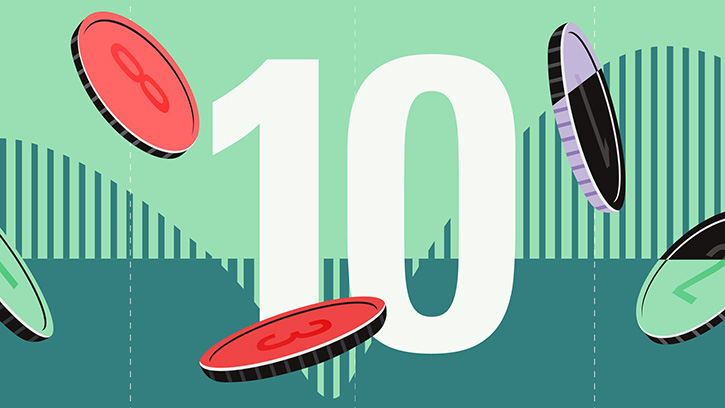Rolle im Portfolio
The UBS MSCI Japan ETF provides equity exposure to one of the biggest economies on the globe and could therefore be considered for use as a core component of a well diversified portfolio to gain exposure to the world’s third-largest economy. However, before considering an investment in this ETF--either as core building block or a tactical tool--investors should be aware of existing exposure to Japan through other holdings (for example, Japanese equities comprise nearly 10% of the MSCI World Index) to avoid unintentionally overweighting Japanese shares.
Taking a close look at the track record of the Japanese stock market over the last 20 years, one might wonder whether owning Japanese equities as part of a buy-and-hold strategy would be of any benefit. The MSCI Japan Index lost about 27% of its value over that period, compared to a 270% increase in the MSCI World Index. After the Japanese real estate and stock market meltdown in the 1990s, the Central Bank hesitated to intervene. By the time the Central Bank made a concentrated effort to stimulate the economy, flooding the market with trillions of yen and decreasing interest rates, the economy was already in a deflationary spiral and consumers had lost faith. Low interest rates from there on made the Yen an attractive target for carry traders, helping to strengthen the currency and ultimately hurting exports.
The index is well diversified with little concentration in specific stocks. Its top holding is Toyota representing 5.2% of its value. The index’s top sector allocation is currently industrials, representing 20.2% of the index’s value. Given this high degree of diversification across individual names, the ETF is best used if the investor believes in a broad-based improvement in the Japanese economy as the country moves through a rebuilding period.
Fundamentale Analyse
Japan’s stock market continues to underperform those of other developed markets. Despite posting its strongest start to any year since 1988, surging almost 20% in Q1 2012, the MSCI Japan Index has appreciated by only 5.4% year-to-date. By way of comparison, the S&P 500 Index and the EURO STOXX 50 Index have gained 15.9% and 14.8%, respectively, on a year-to-date basis.
In August, Japan posted a trade deficit of $9.62bn, its second straight monthly shortfall. The deficit grew by 45% m/m but remained below market expectations. The deficit was mainly driven by slowing overseas demand, further underscoring the difficult economic situation of the export-driven economy. The strength of the yen and the on-going sovereign debt crisis continue to weight on Japan’s exports. Exports to Europe dropped by 22.9% y/y in August, while exports to Asia were down by 6.7%. Especially China was a drag as exports was 9.9% lower. At the same time, exports to the US increased by 10.3% on the back of a modest recovery. Moreover, as a result of a recently inked free trade agreement, Japan has emerged as a major steel exporter to India over the past five months. Between April and August, Japan’s steel exports to India have surged by 64% from a year earlier.
After last year’s disaster in Fukushima, the government has announced plans to phase out nuclear power plants over the next three decades. This will lead to a surging energy import bill in the years to come, making Japan more vulnerable to fluctuating commodity prices.
In September, the Bank of Japan took market participants by surprise, announcing an aggressive expansion of its monetary-easing program. The BOJ increased its bond-buying program by ¥10 trillion to ¥80 trillion and pushed back the program’s deadline to the end of 2013. However, the Bank’s actions have raised concerns amongst investors as they fear the Bank will engage in “competitive easing” by flooding the economy with money despite the potentially negative impacts it might have elsewhere. Low interest rates in the US caused by the Fed’s quantitative easing program have been partly blamed for the persistent strength of the yen.
Industrials, the largest index sector represented in the index, continue to suffer under the strong yen. Since mid-2008, the yen has appreciated by over 30% against the USD and by almost 70% against the euro. In particular auto makers have struggled to compete on the basis of either price with their US, German, and South Korean rivals due to the yen’s strength. Toyota, the largest index constituent, is affected the most as it still manufactures over 40% of its global volume in Japan. As a result, companies are increasing their efforts to move their production abroad. This could ultimately have a negative impact on Japanese employment.
However, the consumer sector, the second largest sector of the Japanese economy, has done well so far this year. Also, as weakening global demand has suppressed exports, domestic demand continues to benefit from reconstruction-related activities. Strong domestic demand and possible wage growth could help the country to break out of its long-running deflationary trend.
Indexkonstruktion
The MSCI Japan Index includes approximately 316 of the largest stocks of publicly-traded companies based in Japan. Components must meet minimum criteria for liquidity, foreign ownership restrictions, and a waiting period for newly-listed stocks. The securities are weighed by free-float adjusted market capitalisation. Because closely held firms will have a smaller piece of their aggregate market capitalisation floated on public exchanges, the free float adjustment serves to ensure the underlying liquidity of the holdings is superior relative to a pure market capitalisation weighting. The index is reviewed four times a year. As of writing, the index is biased towards industrials (20% of the index’s value), followed by consumer discretionary (19%) and financials (19%).
Fondskonstruktion
The UBS MSCI Japan ETF uses physical replication techniques to track the performance of its benchmark, the MSCI Japan index. Given that the index’s components are all very liquid, the fund holds them all in proportion to their weighting in the index, eliminating the potential for tracking error that index sampling might introduce. The fund may lend up to 50% of its assets to generate revenues to also help minimise tracking error. This practice introduces counter-party risk as the party to whom the securities are lent may default, and it is left to investors to decide whether or not the additional income generated through securities lending is adequate compensation for the level of risk entailed. To minimise this risk, UBS restricts securities lending to pre-defined counterparties, holds collateral in a ring-fenced third-party account with State Street Bank, and marks the collateral's value to market daily. UBS and third-party agents such as Clearstream Banking and Euroclear manage the securities lending process, including monitoring collateral values. The ETF distributes dividends twice a year. Movements in the benchmark in excess of returns on cash during the period between when the fund receives dividends and the date it distributes them will result in 'cash drag', which can be a source of tracking error.
Gebühren
The total expense ratio (TER) for this fund is 0.52%. This lies in the upper of the range for ETFs tracking Japanese equities.
Alternativen
There are two other Japanese large-capitalisation indices popular with ETF providers, the Nikkei 225 and the TOPIX. There is little to choose from between the MSCI Japan and TOPIX indices, but the Nikkei 225 has a far smaller allocation to financial services (about 1%) and utilities (less than 1%) with the difference spread amongst multiple sectors. The iShares Nikkei 225 ETF uses physical replication and levies a TER of 0.50%. UBS' MSCI Japan ETF has the greatest trading volume of any ETF tracking that index. The Lyxor Japan TOPIX ETF uses synthetic replication and has the greatest trading volume of any ETF tracking that index and charges a TER of 0.50%.
There are five ETFs tracking the TOPIX, including one from EasyETF, one from ComStage, two from Lyxor (one trading in pounds sterling and one trading in euros) and one Euro hedged version from RBS. While ComStage's ETF charges a slightly lower TER of 0.45%, Lyxor's euro-denominated ETF has the greatest daily average on-exchange trading volume, making it a less expensive choice--in terms of the total cost of ownership--for many investors.
Die in diesem Artikel enthaltenen Informationen dienen ausschließlich zu Bildungs- und Informationszwecken. Sie sind weder als Aufforderung noch als Anreiz zum Kauf oder Verkauf eines Wertpapiers oder Finanzinstruments zu verstehen. Die in diesem Artikel enthaltenen Informationen sollten nicht als alleinige Quelle für Anlageentscheidungen verwendet werden.

















